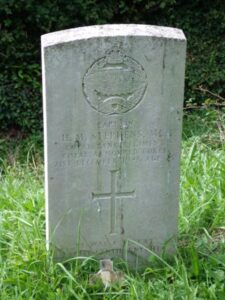The Parish of St. Ishmaels, located on the Towy Estuary, includes the Villages of Ferryside and Llansaint, the Hamlets of Broadlay and Broadway and the surrounding farms. The area has a long history, being on the Pilgrims Way across South Wales to St. David’s Cathedral, and is straddled by Isambard Kingdom Brunel’s Railway Line, which stretches across South Wales. The War Memorial at Ferryside takes the form of a Celtic Cross, carved in Granite, and the men commemorated by it are remembered below.
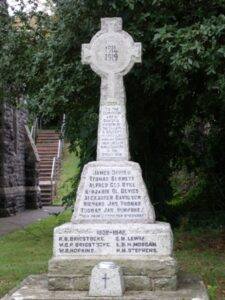
The Great War, 1914-1918
Thomas Lewis Bennett, Sapper, 175528, Royal Engineers. Thomas was born at Kidderminster in 1894, the son of Thomas and Elizabeth Bennett. The family had moved to the School House, Ferryside prior to the outbreak of war, where Thomas became a Policeman, and his father ran his own grocery business. Thomas enlisted at Carmarthen into the Pembroke Yeomanry in December 1914, and on 18 June 1916 transferred into the Royal Engineers. He was posted to France, and served as a Sapper in 174 Tunnelling Company from 8 July 1916. This Tunnelling Company served on the Western Front throughout the war, and Thomas joined them on the Somme. By October 1916,174 Tunnelling Company had moved north of the Ancre, facing Beaumont-Hamel, before following the German withdrawal in 1917 towards the Cambrai area. Thomas was killed in action here on 20 November 1917, during the Battle of Cambrai. He was 23 years old and was buried in Croisilles Railway Cemetery, France. His grave was lost during the battle but as he was definitely known to have been buried in the cemetery, Thomas is now remembered by a Special Memorial. His parents later moved to the Red Lion Hotel, Drefach, Henllan.
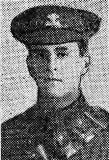
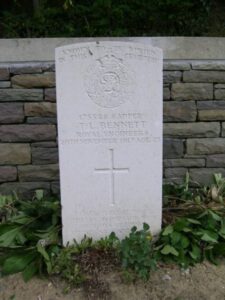
Alexander Davidson, Second Engineer, Mercantile Marine. Alexander was born at Haverfordwest in 1860, the son of Alexander and Elizabeth Davidson. Alexander had married Mary Thomas some years prior to 1888, and the couple lived at 23, Brigstocke Terrace, Ferryside. He followed his father into the Mercantile Marine, and by the time of the war was serving aboard the S.S. Boltonhall, a defensively armoured steamship, owned by the West Hartlepool Steam Navigation Company. On 20 August 1918, the ship was 34 miles off Bardsey Island when she was torpedoed and sunk by a German submarine. Five crewmembers died including Alexander. He was 57 years old, and is remembered on the Tower Hill Memorial, London, alongside his fellow crewmen.
Benjamin Daniel Davies, Lance Corporal, 13114, Welsh Regiment. Benjamin was the son of John and Margaret Davies, The Stores, Ferryside, and enlisted at Carmarthen with his cousin James into the Welsh Regiment. Benjamin landed in France on 18 January 1915, and was posted to the 2nd Battalion, Welsh Regiment, which was attached to 3 Brigade, 1st Division near Festubert. The division remained in Flanders during the first winter, and fought at Aubers, before moving South to Loos, where they took part in the Battle of Loos on 25 September. After suffering heavy casualties during the battle the Division was brought out of the line to rebuild and rest, and moved further south in 1916 to the Somme area. It took part in the opening Battle of Albert during the Somme offensive, and this is where Benjamin was wounded. He was brought back to the Casualty Clearing Station at Albert, where he sadly died of wounds on 12 July 1916, aged 27. He is buried in Albert Communal Cemetery Extension, France.
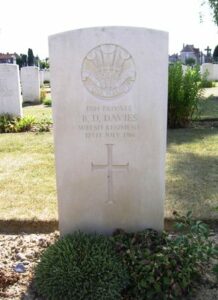
David John Davies, Private, 3091, Welsh Guards. David was the son of John and Margaret Davies, of Pant, St. Ishmael’s. He enlisted at Carmarthen into the Welsh Guards, which had been formed by Royal Warrant on 26 February 1915. The 1st Battalion, Welsh Guards moved to France, landing at Havre on 18 August 1915, where it was attached to the 3rd Guards Brigade, Guards Division and saw its first action during the Battle of Loos. The Guards wintered on the Ypres Salient, and remained there until 27 July 1916 when the division moved South to the Somme, to take part in the ongoing Somme offensive. The Guards Division saw heavy fighting on the Somme, during the Battles of Ginchy, Flers-Courcelette and Morval before spending the Winter of 1916/17 in the Somme trenches. The division moved out of the line at the end of March 1917 to rest and refit before taking over a section of the line north of Ypres, to the left of the 38th (Welsh) Division at Pilckem Ridge. David was reported to have been shot dead by a sniper while carrying a despatch during the divisions assault on the Pilckem Ridge on 31 July 1917, aged 22. His grave was lost in the Flanders mud so he is commemorated on the Menin Gate Memorial, Ypres, Belgium. He is commemorated at Llansaint and there is also a memorial plaque to David in St. Ishmael’s Church, Ferryside but he is not commemorated on the main war memorial at Ferryside.
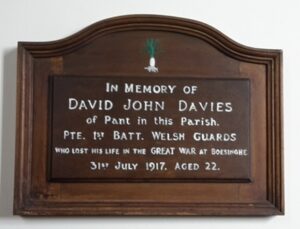
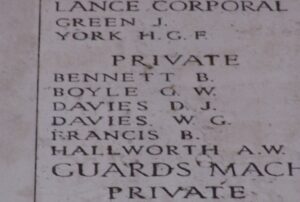
David Tom Davies, Private, 531587, Labour Corps. David was the son of William and Miriam Davies, of Broadway, Ferryside. He enlisted at Llanelli into the King’s Liverpool Regiment, but was later transferred to the Labour Corps. David looks to have lied about his age when he enlisted, and never served overseas. He died on 9 November 1918, officially aged 19, but was probably only 17. David is buried at Ferryside (Salem) Baptist Burial Ground. David is not commemorated on the Ferryside Memorial.
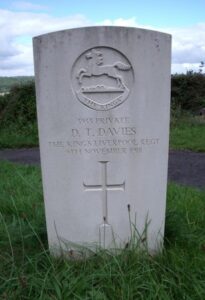
James Davies, Lance Corporal, 13092, Welsh Regiment. James was the son of David and Eliza Ann Davies, of Carlton House, Ferryside. He enlisted at Carmarthen with his cousin Ben Davies into the Welsh Regiment, and was posted to France on 18 January 1915, and was posted to the 2nd Battalion, Welsh Regiment, which was attached to 3 Brigade, 1st Division near Festubert. The division remained in Flanders during the first winter, and fought at Aubers, before moving South to Loos, where they took part in the Battle of Loos on 25 September. After suffering heavy casualties during the battle the Division was brought out of the line to rebuild and rest, and moved further south in 1916 to the Somme area. It took part in the opening Battle of Albert during the Somme Offensive, and it was at a later stage, during the Battle of Pozieres, that James was Killed in Action, on 26 July 1916, aged 21. He is remembered on the Thiepval Memorial, France.
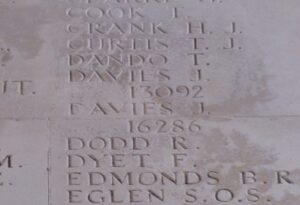
John Davies, Yeoman of Signals, 198789, Royal Navy. John was born in Ferryside on 6 September 1882, the son of Henry and Mary Davies. He joined the Royal Navy on his birthday, on 6 September 1900, and served on such renowned vessels as HMS Impregnable and HMS Black Prince over the coming years. He married in 1905, and set up home with his wife Sarah Jane Davies at 7, Monument Street, Devonport, where they raised at least four children. John had steadily made his way up through the ranks in the Royal Navy and was posted aboard the brand-new light-cruiser HMS Constance, aboard which he took part in the Battle of Jutland, serving aboard her until being posted to HMS Comus on 26 June 1918. He took ill while Comus was stationed in Scotland with the 1st Light Cruiser Squadron, and died of influenza at the RN Hospital, South Queensferry, on 24 February 1919, aged 37. His body was brought home for burial in Plymouth (Weston Mill) Cemetery, Devon. John is not commemorated at Ferryside.
Alfred George Dyke, Private, 31641, King’s Shropshire Light Infantry. Alfred was the son of Robert and Minnie Dyke, of Ferryside. He enlisted at Llanelli into the Territorial Army, and was posted to France at some time in 1917, joining the 1/4th Battalion King’s Shropshire Light Infantry. On 18 August 1917 the battalion had moved to France from the Far East, joining 190 Brigade, 63rd (Royal Naval) Division. They were immediately thrown head first into battle at the Second Battle of Passchendaele, suffering heavy casualties in the final attacks against the ridge. After a brief rest period, the Division was sent to the Somme, and from there to Marcoing, where it took part in the Battle of Cambrai, reaching their lines in time to meet the German counter-attack of 30 December at Welsh Ridge. The attack was held, and the winter of 1917/18 was spent in the wet trenches in the Cambrai area. On 4 February 1918 the battalion transferred to 56 Brigade, 19th (Western) Division. The German Spring Offensive was launched on 21 March 1918, and the Shropshires were hit by German gas shells at Beaulancourt, before moving into position near Bertincourt to meet the attack. The village of Doignies had fallen, so the Shropshires moved to attempt to retake it, and so began a period of terrible slaughter for the division. Alfred was killed in action here on 26 March 1918, aged 19. His body was lost in the further fighting in the area, and so he is remembered on the Arras Memorial, France.
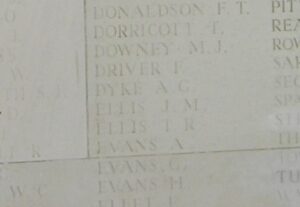
David Arthur Griffiths, Ordinary Seaman, Z/5091, Royal Navy. David was born on 22 June 1900, the son of David and Ellen Griffiths, of 2, Annesley Street, Llanelly. He was a Boy Writer at Pembroke Dockyard, prior to serving as Ordinary Seaman in the Royal Navy, at HMS Victory VI. The base was a training base for recruits, based at Crystal Palace. David took ill while training here, and died of pneumonia on 14 October 1918. He was only 18 years old. His remains were brought home for burial at Llanelli (Box) Cemetery. David is listed as a Ferryside man on the County War Memorial roll, but is not on the memorial.
Thomas Hanson, Private, 26198, Welsh Regiment. Thomas was born in Chelsea in 1894. By 1911 he had moved to work as a farm servant at Trelech Vicarage, and prior to the war was living at Ferryside. He enlisted at Carmarthen into the 17th Battalion, Welsh Regiment, which was part of 119 Brigade, 40th (Bantam) Division. The Division had moved to France during June 1916 and served near Loos until October that year. They moved to the Somme, where they took part in the final Battle there that year, at the Ancre, and then wintered o the Somme, before following the German retreat to the Hindenburg Line. It was during this period on the Somme that Thomas Died, on 6 February 1917, aged 22. He is buried at Bray Military Cemetery, France. Thomas is not named on the Ferryside Memorial.
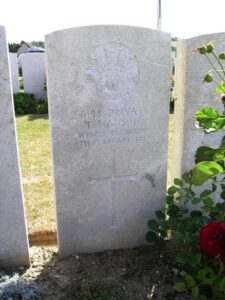
Albert House, Private, 17938, Oxfordshire and Buckinghamshire Light Infantry. Albert was the son of George and Eliza House, of Thatcham, Berkshire. He worked as a railway platelayer prior to the war, and in 1907 married Martha Anne Bowen, of Railway Terrace, Ferryside. The couple resided there for at least four years, where their children Harold and Emily were born, before moving to Pontardulais. Albert enlisted at Swansea into the army, and was posted to the 7th Battalion, Oxfordshire and Buckinghamshire Light Infantry, who were attached to 78 Brigade, 26th Division. The Division moved to France in September 1915 and assembled around Amiens, but were sent to Salonika in November that year, and were all in place there by February 1916. The Division fought in the Battle of Horseshoe Hill in August 1916, and in April and May 1917 fought in the Battle of Doiran, where Albert was killed in action on 26 April 1917, aged 34. He is buried at Sarigol Military Cemetery, Kriston. Albert is not named on the Ferryside Memorial. His widow Martha married Llewellyn Francis, of Pontardulais in 1920, before returning to Ferryside to live, and died in 1972.
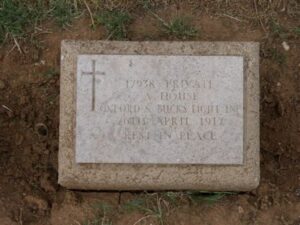
William Howells, Gunner, 122051, Royal Artillery. William was the son of Lewis and Mary Howells, of Neptune Villa, Ferryside, and enlisted at Carmarthen into the Royal Artillery, where he was to serve in their ‘X’, 32nd Trench Mortar Battery. This Battery was attached to the 32nd Division, which had moved to France in 1915. They fought throughout most of the Somme Offensive in 1916, and followed the German retreat to the Hindenburg Line in 1917 before taking part in the Battle of Arras, when the German Spring Offensive was launched against the City in March, 1918. They remained on the Somme, fighting during the retreat towards Albert, then in the advance past Bapaume and on through the mighty Hindenburg Line, which they pushed through on towards the Sambre, where William was Killed in Action on 4 November 1918. He was 23 years old, and is remembered on the Vis-en-Artois Memorial, France. William is not named on the Ferryside Memorial.
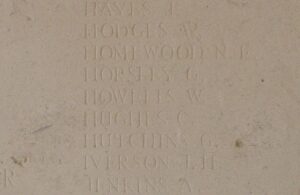
Thomas James Humphreys, Private, 60429, Cheshire Regiment. Thomas was the son of James and Emily Humphreys, of Wellfield Terrace, Ferryside. He enlisted at Llanelli into the South Wales Borderers, but at some time transferred into the 1/4th Battalion, Cheshire Regiment, part of 159 Brigade, 53rd (Welsh) Division. The Division had moved to Gallipoli by 9 August 1915 and fought there through the terrible winter that year, suffering many casualties, before it was evacuated to Egypt in December. Here it moved to the Palestinian front, and pushed the Turks North through the Sinai, towards Gaza. It was during the Third Battle of Gaza that Thomas was wounded. He was evacuated to Beersheba, but died of wounds there on 13 November 1917, aged 18. Thomas is buried in Beersheba War Cemetery, Israel.

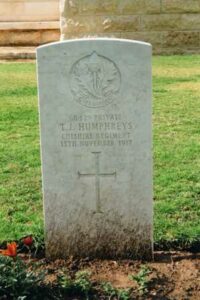
George Jenkins, Lance Corporal, 1370, South Wales Borderers. George was born at Stretton Sugwas, Herefordshire in 1890, the son of Arthur Jenkins and Isabella Jenkins (nee Vale, formerly Stephens). The family had moved to Heol-y-Dwr, Hay by 1901 and Arthur was working as a woodman and timber feller. George worked as a gardener for Lady Glanusk as a young man and enlisted at Hay into the 1st Volunteer Battalion, South Wales Borderers on 5 April 1907. On 3 April 1908 the battalion became the Brecknockshire Battalion, South Wales Borderers, following the formation of the Territorial Army. George attended the annual TA Summer Camp at Porthcawl that year, but then left Hay in 1910 after gaining work as a gardener for Mary Brogden, at Iscoed, Ferryside, Carmarthenshire. Iscoed was the former home of the Welsh war hero, General Sir Thomas Picton, a contentious figure who had been killed at the Battle of Waterloo. George returned to Hay as soon as war was declared and re-joined the Brecknockshire Battalion, South Wales Borderers. The battalion was attached to the Welsh Division and moved to Pembroke Dock upon mobilisation. It was then withdrawn from the Division and on 29 October 1914 sailed from Southampton for Bombay, where the battalion transhipped and sailed for Aden, arriving on 16 December 1914. The climate in Aden was fearsome, with scorching heat during the day, and with little to do, the men spent much of their free time playing football. By June 1915 the Turks had become overconfident due to the lack of any incursions by the British into Yemen and moved forward to reoccupy fortifications at Sheikh Saad. They then began to shell the island of Perim, so the Allied troops in Aden were mobilised into the Aden Movable Company and ordered to prepare to join with local troops. 400 men of the Brecknocks were allocated to the column, the remainder stayed in Aden. A small artillery column was built up to join it and on 3 July the force moved out to Sheikh Othman. Many men collapsed on the march, which was carried out during the full heat of the day, but by 7.30 pm the column had completed its six mile advance. George was among thirteen men who died of heatstroke during the following day, 4 July 1915, during an even longer march. The 25-year-old has no known grave and is commemorated on the Heliopolis (Aden) Memorial, Egypt. George is not commemorated at Ferryside.
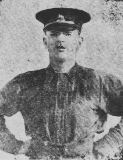
Evelyn Llewellyn Hustler Jones, Second Lieutenant, Royal Welsh Fusiliers. Evelyn was born on 29 July 1874, the son of the Reverend Owen Jones and Mrs. Augusta Frederica Jones, of St. Ishmael’s Vicarage, Ferryside. He was a Barrister at Law prior to the war, and was educated at Newton Abbot College, and Trinity College, Oxford. Evelyn was commissioned from the Inns of Court OTC on 11 May 1915 into the Royal Welsh Fusiliers, and was posted to Egypt, where he joined the 1/5th Battalion, Royal Welsh Fusiliers, which was attached to 158 Brigade, 53rd (Welsh) Division. In March 1916 the Division crossed into Palestine, with the aim of freeing the country from Ottoman rule. Evelyn was killed in action during the First battle of Gaza, on 26 March 1917. He was 43 years old, and is commemorated on the Jerusalem Memorial, Israel. Evelyn is not commemorated on the Ferryside Memorial, but on the Kingsteignton War Memorial in Devon.
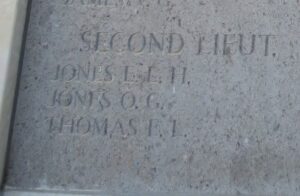
Arthur Glanmor Lewis, Second Lieutenant, Monmouthshire Regiment. Arthur was the son of George and Eleanor Eliza Lewis, of Broadlay House, St. Ishmaels. When he was young his parents moved from St. Ishmaels to Marlow, Buckinghamshire, where he was educated and became a member of the Marlow Rowing Club. He was commissioned into the 3rd Battalion, South Wales Borderers before being attached to the 1st Battalion, Monmouth Regiment, which was attached to the 46th (North Midland) Division. Arthur was killed in action during heavy fighting at Vermelles, during a German counter-attack on 13 October 1915. He was just 19 years old and is buried in Loos British Cemetery, France. Arthur is not commemorated locally.
Richard John Thomas, Private, 41200, South Wales Borderers. Richard was the son of John and Caroline Thomas, of 1, Pale House, Ferryside. He was a railway labourer prior to the war and enlisted at Carmarthen into the Welsh Regiment. He subsequently transferred into the 2nd Battalion, South Wales Borderers. The 2nd SWB had fought in China at the outbreak of war, and had then fought at Gallipoli with 87 Brigade, 29th Division. Richard probably joined them in France. The Division played a large part in the Battles of the Somme, fighting from the start on 1 July 1916 until the Battle was called off in December, and they then moved to Arras, fighting at the Battle of the Scarpe. They then fought through the battles of Third Ypres, before moving to the Cambrai area, where they took part in the Battle of Cambrai. It was during this battle that Richard was sadly killed in action, on 21 November 1917, aged 28. He is remembered on the Cambrai Memorial, Louverval, France.
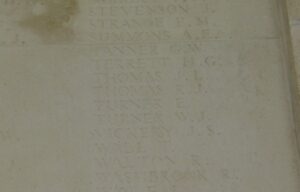
World War Two, 1939-1945
Robert Benet Player Brigstocke, Private, Home Guard. Robert was born on 20 May 1912, the son of George Robert Brigstocke (Lord of the Manor of Ryde), and Anna Cecilia Brigstocke (nee Lewes) of Roberts Rest, Ferryside. He was baptised at St. Ishmael’s Church, Ferryside on 29 May 1912. Robert had studied at Oxford, before working as a Land Agent in Norfolk prior to the war and resided at Church Street, Wayland, Norfolk. He enlisted into the Home Guard as soon as war erupted and was posted to the Isle of Wight. He died at Maycroft Nursing Home on the Isle of Wight on 31 December 1943. The 31-year-old was buried in the family grave at Ryde, Isle of Wight. His brother William had died of wounds in 1940 whilst serving with the Royal Navy.
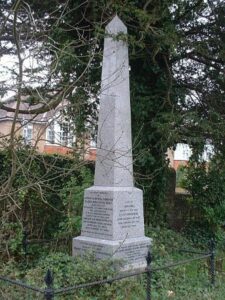
William George Player Brigstocke, Lieutenant, Royal Naval Volunteer Reserve. William was born on 14 June 1910, the son of George Robert Brigstocke (Lord of the Manor of Ryde), and Anna Cecilia Brigstocke (nee Lewes), of Roberts Rest, Ferryside. He was baptised at St. Ishmael’s Church, Ferryside on 25 Jun 1910. In 1938 he married Gladys Veronica Wigram, of Weybridge, Surrey. William was educated at Sherborne, and at Manchester University, where he studied as an Electrical Engineer, and joined the Royal Naval Volunteer Reserve around 1930. When war erupted, William was posted aboard the requisitioned Merchant Ship HMS Foylebank. The Foylebank had been requisitioned in September 1939, and converted into an anti-aircraft ship. She arrived in Portland on 9 June 1940 for work-up followed by anti-aircraft duties. On 4 July 1940, whilst the bulk of her crew were at breakfast, unidentified aircraft were reported to the south. They were mistakenly identified as friendlies returning to base, but turned out to be a flight of 26 Junkers 87 Stuka dive bombers, heading towards the Foylebank. The gunners aboard Foylebank began firing on the Stukas, shooting down three, but 22 bombs found their mark and her guns were put out of action. Fires raged, electricity failed and the stricken ship listed to port, shrouded in smoke. William was wounded in the attack, and died of wounds that day, on 4 July 1940. He was 30 years old and is buried at Ryde Borough Cemetery, in the family grave. Foylebank sank on the following day, 5 July 1940. During the gallant defence of the ship Leading seaman Jack Mantle, one of the Ack-Ack gunners, received the Victoria Cross for gallantry, for staying at his post, even after suffering terrible injuries. William’s brother, Robert, died in 1943 whilst serving with the Home Guard.
William Richard Hopkins, Sergeant, 610971, Royal Air Force. William was born at Ystradfodwg on 10 September 1920, the son of Evan Hopkins and Louisa Mary Hopkins (nee Harris). His parents moved to Ferryside just after the outbreak of war. William enlisted into the Royal Air Force Volunteer Reserve just prior to the outbreak of war and after qualifying as a Flight Engineer was posted to 15 Squadron Royal Air Force. During 1938, the Squadron was one of the first to receive Fairey Battles, and it was with these that 15 Squadron flew to France in September 1939. In early 1940, the Squadron returned to the UK and re-equipped with Bristol Blenheim’s, flown in the ground attack role. By the turn of the year, these had been traded in for Wellingtons, and shortly after that 15 Squadron became one of the first Short Stirling heavy-bomber units, and were based at RAF Bourn, Cambridgeshire as part of 3 Group. On the night of 27 August 1942, William took off from RAF Bourn, aboard a Short Stirling I, Serial BF327, which joined a large force of some 305 other bombers despatched to strike the Henchel aircraft factories in Kassel. The raid was a success, but suffered the loss of 31 aircraft, 10% of the strike force. William was killed when his Stirling was shot down by a German night-fighter and crashed at Beusichem on the south bank of the River Lek, during the early hours of 28 August 1942, killing all seven of her crew. The 21-year-old was buried besides his fellow crewmen in Amersfoort (Oud Leusen) General Cemetery, Netherlands.
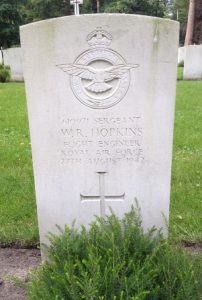
Ernest Henry Jenkins, Third Officer, Merchant Navy. Ernest was born on 22 March 1917, the son of George Stephenson Jenkins and Elizabeth Jenkins (nee Lloyd), of 6, Railway Terrace, Ferryside. He left home as a young man and joined the Mercantile Marine. Ernest married Anne Elizabeth Holman at Battersea in 1940 and the couple made their home at Wimbledon Park, Surrey. He was by now serving aboard the Liverpool registered merchant steamer, SS Culebra. On 25 January 1942, Culebra was in the North Atlantic, having left London via Loch Ewe for Bermuda and Kingston, Jamaica carrying a general cargo. The ship was attacked by the surfaced German submarine U-123, which used her deck gun to destroy the lone ship, which sank with the loss of all 45 of her crew. Ernest was 24 years old when he died that day. He has no known grave but the sea, so if commemorated alongside his fellow crewmen on the Tower Hill Memorial, London. Ernest is not commemorated on the Ferryside war memorial.
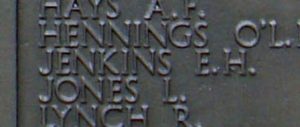
Edward Morland Lewis, Captain, 171535, General List. Edward was born in Carmarthen in 1903, the eighth son of Benjamin Archibald Lewis and Mary Lewis (nee Fuller), of Morfa House, Carmarthen. His father had been the Manager of the Carmarthen Gas Works, but after retiring moved the family moved to Undercliff, Ferryside. After leaving Carmarthen Grammar School, Edward trained at St John’s Wood School of Art and at the Royal Academy, London where he became a favoured student of Sickert, and painted many local scenes, especially of Ferryside. He then joined the staff of Chelsea College of Art, where his colleagues included Henry Moore, Graham Sutherland and John Piper. Edward married Kathleen Margaret Faussett-Osbourne, a fellow artist, of Kensington, London, in the Spring of 1940. He gained a commission into the army soon after the outbreak of war, being placed on the General List, and was posted to North Africa, where he served as a Camouflage Officer. Edward died of malaria in hospital in Tunisia on 4 August 1943. The 40-year-old was buried in Medjez-El-Bab War Cemetery, Tunisia.
Edwin Denzil Horace Morgan, Aircraftman 2nd Class, 1123734, Royal Air Force Volunteer Reserve. Edwin was born in 1906, the son of Joseph and Elizabeth Maud Morgan, of 2, Neptune Villa, Ferryside. He enlisted into the Royal Air Force Volunteer Reserve and was posted to No. 9 Recruits Centre, Technical Training Command, at Blackpool. Nothing else is known of his war service at the moment but Edwin died at Blackpool on 12 March 1941. The remains of the 34-year-old were brought home and he was buried in Salem Baptist Burial Ground, Ferryside.
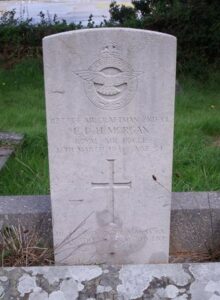
Hugh Martin Stephens, MC, Captain, 123552, Royal Tank Regiment. Hugh was the son of Hugh Owen Taylor Green Stephens and Ragnhild Margarete Stephens. His father was from Ferryside, and married his mother, a Belgian refugee, in 1915. Prior to WW2, the family had moved to Bedford. On 8 March 1940 Hugh was gazetted from Sandhurst to be 2nd Lieutenant in the Royal Tank Regiment, and was promoted to full Lieutenant on 2 September 1941. The 1st RTR was attached to the 7th Armoured Division, the famous ‘Desert Rats’, and Hugh fought with them in North Africa, during the Battle of El Alamein where they were equipped with Stuart and Grant Tanks. In September 1943 the Desert Rats landed in Italy at Salerno, and saw heavy fighting once again. On 25 April 1944 Hugh was approved by the King to be Mentioned in Despatches in recognition of gallant and distinguished service in the field in the London Gazette. As Montgomery’s old command, he wanted the 1st Royal Tank Regiment to be with him during the invasion of Europe, so the regiment was recalled to England to prepare for the invasion of France. On D-Day, 6 June 1944, the 1st RTR landed at Arromanches, and fought hard during the break-out from Normandy and the subsequent drive through Norther France into Belgium and Holland, taking part in Operation Market Garden and the crossing of the Rhine into Germany. Hugh was obviously a gallant man, as can be seen in the following recommendation for him to be awarded a Military Cross: ‘Capt. Stephens has been commanding a troop of tanks in this regiment since D-Day and has taken part in every action of the regiment from that day until he was very seriously wounded on 30 March. On every single occasion in action this officer has displayed gallantry, determination and leadership of a very high order. He has had five tanks shot from under him during the campaign and has never failed to show a fine aggressive spirit and cheerful leadership, however exhausted and strained he has been. On two separate occasions he has commanded the Squadron in action for several days at a time and both times he has led the Squadron with the same gallantry and enthusiasm as he has always led his troop. This Officer’s conduct has been a very large factor in maintaining the fighting spirit of the whole regiment especially during the dark days around Caen in July 1944. Captain Stephens has already been recommended for an immediate MC twice for acts of gallantry but has never received an award.’ His Commanding Officer, who wrote this recommendation, was obviously very determined to get Hugh the recognition that he deserved, and the award of the Military Cross was eventually signed off in July 1945. Sadly Hugh was still battling to recover from his wounds after being evacuated back to Britain for treatment at Churchill Hospital, Oxford. He died there of his wounds on 21 December 1945. The remains of the 25-year-old were brought home and he was buried in St. Ishmael Churchyard five days later.
